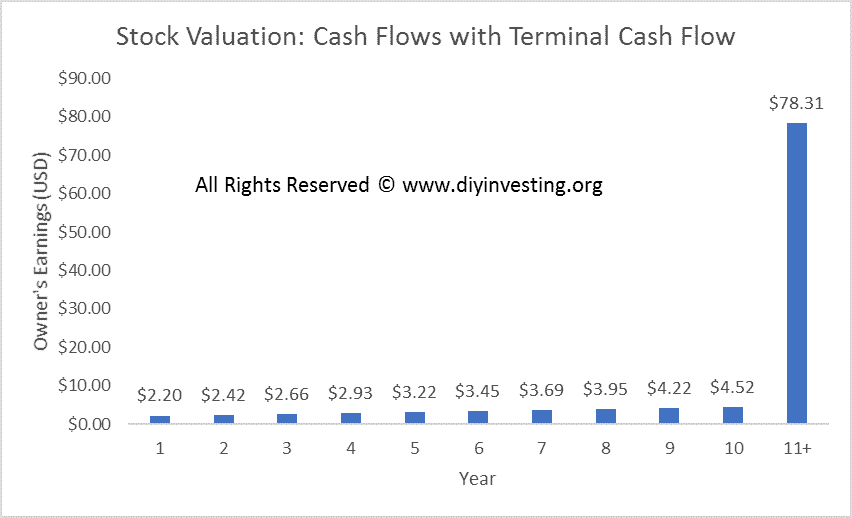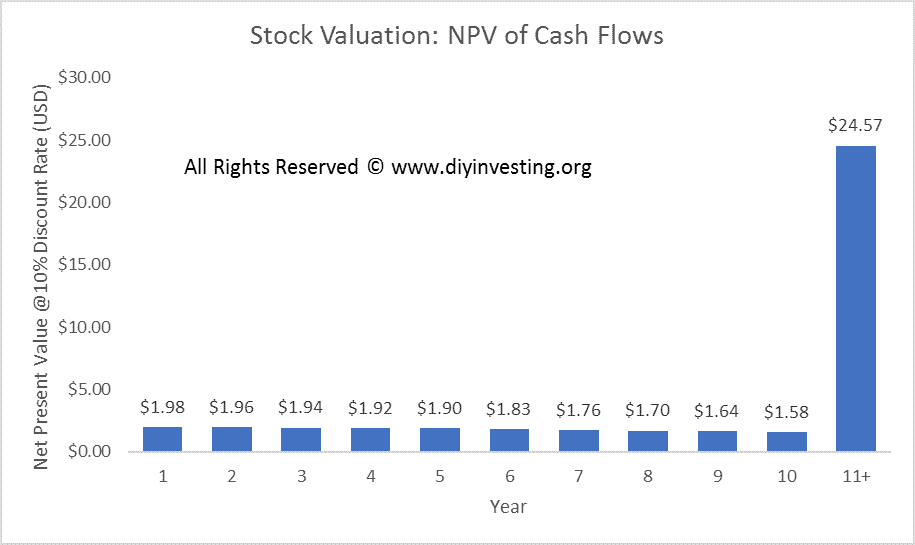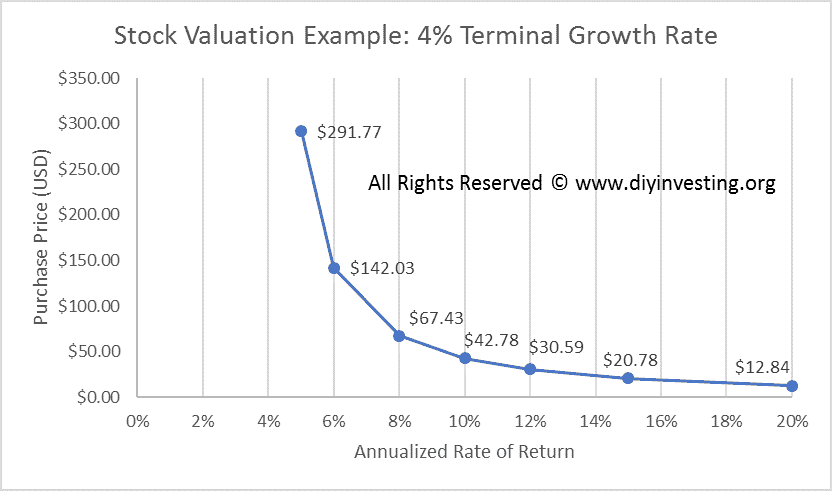Stock valuation is the process of determining the appropriate price to pay for a stock. As we discussed in last week’s article, a bond’s value is based solely on it’s future cash flows. The same is true for stocks. The present value of all future cash flows, represents the intrinsic value of the stock. If we assume that the future cash flows of a company are fixed, then it’s possible to precisely calculate this intrinsic value. Intrinsic value calculations change based upon the discount rate used to adjust future cash flows back to present value. This discount rate is synonymous with an investor’s rate of return. Consequently, this calculation works in reverse as well. It’s possible to predict the rate of return of an investment based upon your purchase price. In this regard, price is paramount in stock valuation.
This article is the 2nd part in a series on the importance of price in investing. Last week, part one discussed bond valuation. Part three will discuss valuation of real-estate. In this article, I will present an example showing how the price you pay for a stock changes the rate of return you will earn. Stock valuation is more complicated than bond valuation due to the inherent uncertainty of predicting their future cash flows. However, once you assume a set of cash flows, it is simple to calculate the price you should pay for the stock.
Stock Valuation Example:
In order to perform a proper stock valuation, you must estimate to a high degree of reliability the future cash flows of the company. It is important to use the proper metric for cash flows. In our bond example, we simply used the flow of cash paid to the owner of the bond. However, that would not be sufficient when analyzing a stock. In this case, although stocks pay cash to owners in the form of dividends, they also retain cash to grow their business. It is this growth of the business, where the vast majority of the value lies for most companies. Therefore, it is preferable to use a cash flow measure that takes into account both dividends and retained earnings. Owner’s earnings is my preferred metric for cash flow.
Owner’s earnings is defined as the amount of cash flows which could be paid out as dividends to owners without negatively impacting the future earnings of the company. In other words, if the company chose a 100% dividend payout policy, without retaining money for growth, how much money could be paid out? It’s important to emphasize that this measure is not usually equivalent to operating cash flow, EBIT, EBITDA or a number of other US GAAP accounting terms. Those terms are simply a starting point to calculate owner’s earnings.
Assumptions – Owner’s Earnings and Growth Rates
- Current owner’s earnings are equal to $2.00 per share.
- Owner’s earnings will grow at a rate of 10% for the next five years, and 7% for the five years after that.
- The company will have a terminal growth rate of 4%.
Our goal is to determine how much a company with the above assumed owner’s earnings is worth. In the chart below, you will find the expected cash flows based upon these assumptions for the next ten years.

Cash Flows including Terminal Cash Flow
The chart above clearly demonstrates the growing earnings profile of the company over the next ten years. However, it fails to include our last assumption of a terminal growth rate of 4%. This assumption means that the company will continue to grow it’s earnings forever. Should this happen, earnings past the tenth year to infinity are going to well exceed earnings over the next ten years. In fact, that’s exactly what we see when looking at the cash flows.

In this chart, we’ve taken out current earnings and are only looking at future years. The final column, 11+, shows the value in year 11 of all future cash flows of the company for years 11 to infinity. That bar is significantly higher than the bars showing individual cash flows over the next ten years. However, this information is incomplete. Each of these individual bars must be discounted back to the present.
Discounted Cash Flow Calculation
If we assume a target rate of return, or discount rate, of 10% the result is shown in the chart below.

By comparing the last two charts, you can see how earnings in future years are worth less than current earnings. This is despite the fact that the earnings are nominally larger in US Dollar terms. However, this chart is extremely useful for determining the stock valuation. Simply add up the number in each column, and you have the intrinsic value of the stock. The total for this example using a 10% discount rate is $42.78. Therefore, if you want to earn a 10% rate of return, the maximum price you can pay is $42.78.
If we change the discount rate used in our calculations, the intrinsic value will change as well. I’ve calculated the intrinsic value for varying discount rates in the chart below.

As you can see, if you want to earn a higher rate of return, you must purchase the stock at a lower price. The relationship between purchase price and rate of return is not simply a correlation. Purchasing at a lower price is the cause of the higher rate of return. It is important to note that the rates of return shown in this example are the long-term rates of return you can expect by owning this asset. Stock prices can vary wildly in the short-term, leading to drastically different results over a shorter time frame. Therefore, although a purchase price of $142.03 would predict long-term returns of 6%, you could experience interim losses if the stock price temporarily dropped to a lower price such as $70.
Investing Lessons and Action Steps
The central lesson to remember is that stock valuation is the process of determining the present value of all future cash flows. Based upon any fixed set of cash flows, the rate of return you will earn increases when you purchase the stock at a lower price. We also learned a few additional lessons:
- It is important to use owner’s earnings as the cash flow metric for valuing stocks.
- The terminal value of all future cash flows plays a large role in the value of a stock.
- If you know the exact cash flows of a stock, it is possible to predict what purchase price you need to buy at in order to earn a specified rate of return.
Action Steps
Before you purchase a stock investment, be sure to first calculate the intrinsic value of it’s future cash flows. Only by knowing this value can you properly evaluate what price you should be willing to pay for a stock.
If you found value in this content, please consider sharing it so that others may find it as well.
Comment if you have any thoughts or questions, so that we may all benefit from your perspective.
